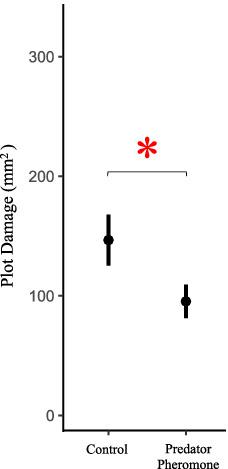当前位置:
X-MOL 学术
›
Ecol. Entomol.
›
论文详情
Our official English website, www.x-mol.net, welcomes your
feedback! (Note: you will need to create a separate account there.)
Predator pheromone elicits a temporally dependent non‐consumptive effect in prey
Ecological Entomology ( IF 2.0 ) Pub Date : 2020-07-09 , DOI: 10.1111/een.12905 Nicholas C. Aflitto 1 , Jennifer S. Thaler 1
Ecological Entomology ( IF 2.0 ) Pub Date : 2020-07-09 , DOI: 10.1111/een.12905 Nicholas C. Aflitto 1 , Jennifer S. Thaler 1
Affiliation

|
The influence of predator cues on the behaviour of prey is well supported in the literature; however, a clear understanding of how predator cues affect prey in variable environmental conditions and over longer time scales is needed to better understand the underlying mechanisms. Here, we measure how predator odors affect herbivore colonization, abundance, oviposition, and plant damage across two growing seasons. The study system consisted of Leptinotarsa decemlineata (Colorado potato beetle) as prey, and the aggregation pheromone of live Podisus maculiventris (spined soldier bug) as the predator cue in a potato field. In 2016, the amount of feeding damage by early beetle colonists was lower in predator odor‐treated plots, reducing plant damage by 22%. Larval abundance was also reduced in treated plots in 2016. Beetle abundance and damage in 2017 was similar in the treatment and control plots. Two mechanisms were investigated to better understand why prey response to the predator odor treatment weakened over the first season, including changes in predator odor cue strength and prey habituation. Predator odor cue strength emerged as a likely explanation, as dispensers, which released a synthetic predator pheromone over the entire season, reduced the probability of finding damage more consistently than the live predator treatment. These results suggest that temporal patterns of predator cue release and strength may drive prey response across the season, underscoring the importance of cue release‐rate and consistency in both species interactions and for the future application of modifying insect behaviour using non‐consumptive effects in agricultural systems.
中文翻译:

捕食者信息素引起猎物的时间依赖性非消耗效应
捕食者线索对猎物行为的影响在文献中得到了很好的支持。然而,需要清楚地了解捕食者线索如何在可变环境条件下和更长的时间范围内影响猎物,以更好地了解潜在机制。在这里,我们测量了捕食者的气味如何影响两个生长季节中食草动物的定植、丰度、产卵和植物损伤。研究系统包括 Leptinotarsa decemlineata(科罗拉多马铃薯甲虫)作为猎物,活的 Podisus maculiventris(刺兵虫)的聚集信息素作为马铃薯田中的捕食者线索。2016 年,在捕食者气味处理过的地块中,早期甲虫殖民者的摄食损害量较低,植物损害减少了 22%。2016 年处理过的地块中的幼虫丰度也有所降低。2017 年的甲虫丰度和损害在处理地块和对照地块中相似。研究了两种机制以更好地理解为什么猎物对捕食者气味处理的反应在第一季减弱,包括捕食者气味提示强度和猎物习惯的变化。捕食者气味提示强度成为一种可能的解释,因为分配器在整个季节释放合成捕食者信息素,比活捕食者治疗更一致地降低了发现损坏的可能性。这些结果表明捕食者线索释放和力量的时间模式可能会推动整个季节的猎物反应,
更新日期:2020-07-09
中文翻译:

捕食者信息素引起猎物的时间依赖性非消耗效应
捕食者线索对猎物行为的影响在文献中得到了很好的支持。然而,需要清楚地了解捕食者线索如何在可变环境条件下和更长的时间范围内影响猎物,以更好地了解潜在机制。在这里,我们测量了捕食者的气味如何影响两个生长季节中食草动物的定植、丰度、产卵和植物损伤。研究系统包括 Leptinotarsa decemlineata(科罗拉多马铃薯甲虫)作为猎物,活的 Podisus maculiventris(刺兵虫)的聚集信息素作为马铃薯田中的捕食者线索。2016 年,在捕食者气味处理过的地块中,早期甲虫殖民者的摄食损害量较低,植物损害减少了 22%。2016 年处理过的地块中的幼虫丰度也有所降低。2017 年的甲虫丰度和损害在处理地块和对照地块中相似。研究了两种机制以更好地理解为什么猎物对捕食者气味处理的反应在第一季减弱,包括捕食者气味提示强度和猎物习惯的变化。捕食者气味提示强度成为一种可能的解释,因为分配器在整个季节释放合成捕食者信息素,比活捕食者治疗更一致地降低了发现损坏的可能性。这些结果表明捕食者线索释放和力量的时间模式可能会推动整个季节的猎物反应,











































 京公网安备 11010802027423号
京公网安备 11010802027423号